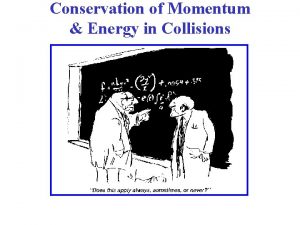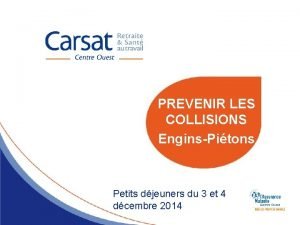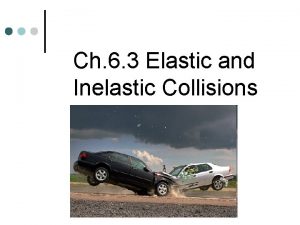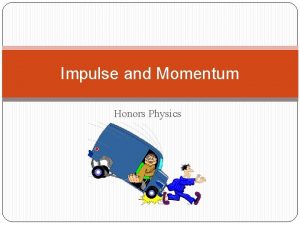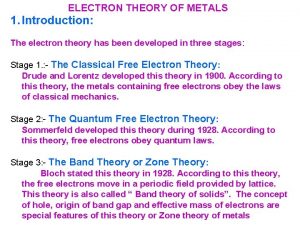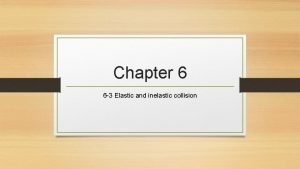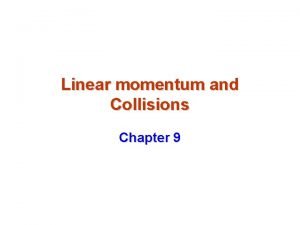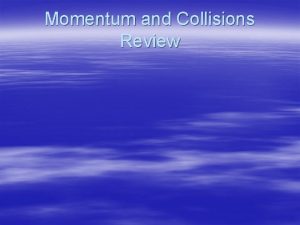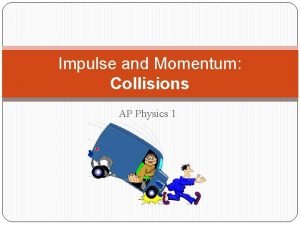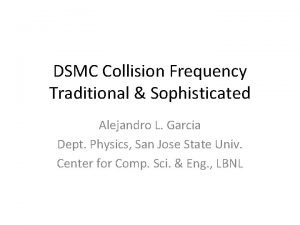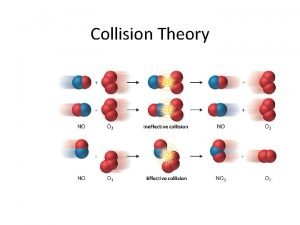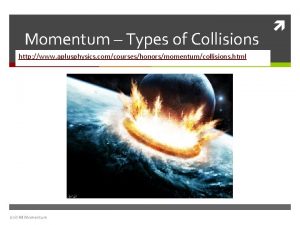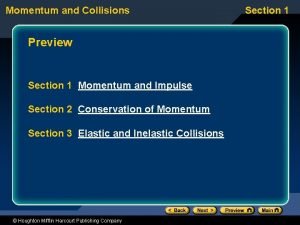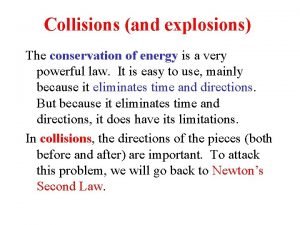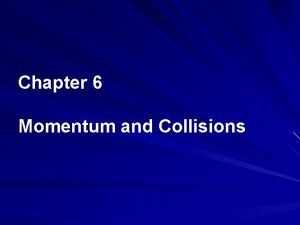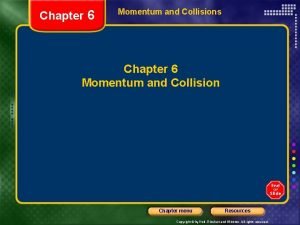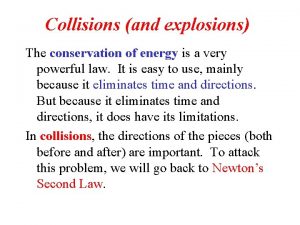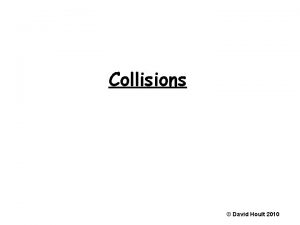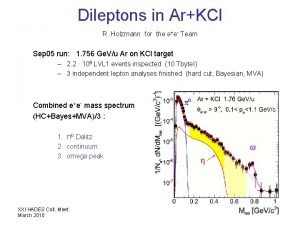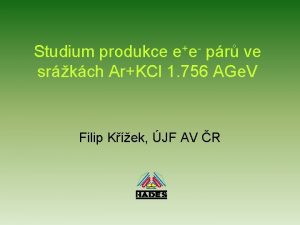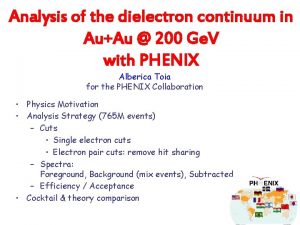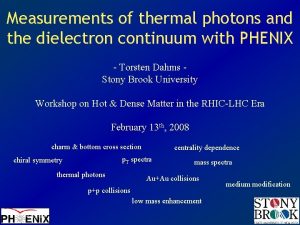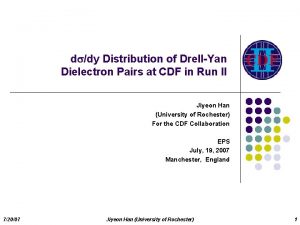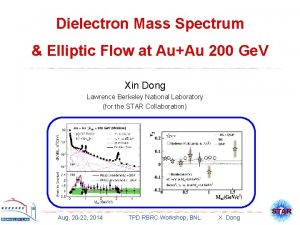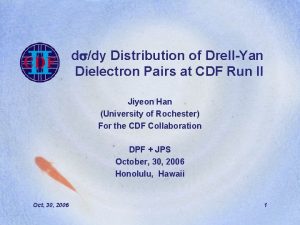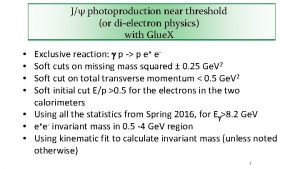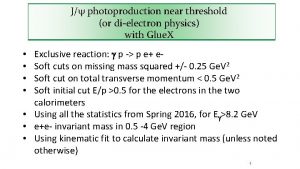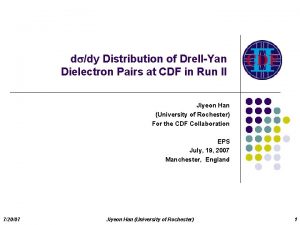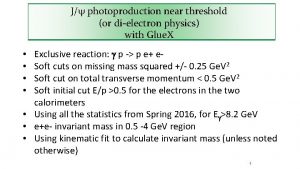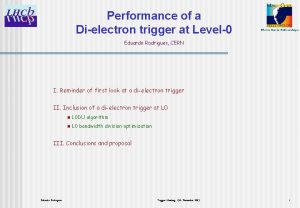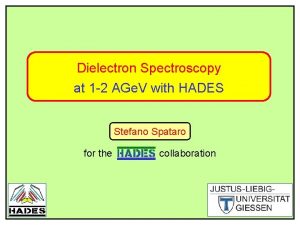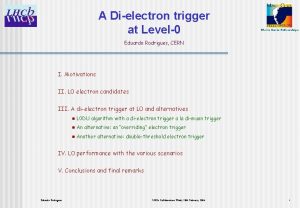Inclusive dielectron production in ArKCl collisions at 1


























- Slides: 26

Inclusive di-electron production in Ar+KCl collisions at 1. 76 A Ge. V with HADES Filip Krizek, NPI Rez for the HADES collaboration § Motivation § HADES detector setup § Results from Ar+KCl run § Discussion and summary 1

Introduction Baryonic matter @ 1 -2 A Ge. V (√s. NN = 2. 3 - 2. 7 Ge. V ): - r/r. N = 1 – 3 , T < 80 Me. V, t ~ 12 – 14 fm/c - nucleons, baryonic resonances, ( mesons < 10%) - very little strangeness The main HADES goal: Properties of r, w in nuclear medium HADES @ SIS via e+e- decay channel (BR 10 -4 - 10 -5 ) - at SIS energies vector mesons produced below or close to threshold - di-electrons emitted over full history of a collision 2

High Acceptance Di-Electron Spectrometer • • GSI Darmstadt SIS accelerator facility. (HI beams 1 -2 A Ge. V) Geometry: • • full azimuthal angle, polar angle 18 – 85 deg pair acceptance ~ 35% Particle identification: • hadron blind Cherenkov detector RICH • time of flight TOF, TOFINO • Pre-Shower Momentum measurement: • superconducting toroidal magnet • multi-wire drift chambers • inv. mass resolution in w region 2. 5% FW 3

HADES trigger Two level on-line trigger: § LVL 1 trigger – charge particle multiplicity § LVL 2 trigger – single electron trigger The case of Ar+KCl run: - Charged part. mult. > 16 - LVL 1 enhanced mean pion mult. 2× w. r. t. MB (MB = Minimum bias) - <Apart> ~ 38. 5 - 34% of events out of MB were selected - total number of LVL 1 events 2. 1× 109 impact parameter distribution of Ar+KCl collisions (Ur. QMD simulation) 4

Ar+KCl @ 1. 76 AGe. V • efficiency corr. spectrum in HADES acceptance normalized to Np 0 • average of two analyses (different pid method: MVA, hard-cut ) Preliminary systematic errors (red ticks) - efficiency corr. ~ 20 % - CB subtraction - p 0 normalization ~ 11% - diff. between both analyses Se+e- = Ne+e- – CB CB : - “like-sign” method - first observation of w production in heavy ion collisions at SIS energies - inv. mass resolution in w region ~ 3% - “mixed-event” technique 5

HSD prediction for Ar+KCl @ 1. 76 AGe. V HSD transport code prediction E. L. Bratkovskaya, W. Cassing, Nucl. Phys. A 807 (2008) 214 -250. • vacuum properties Preliminary • long-lived sources p 0, h, w • pair sources from early collision phase: D → N e+ e- , NN-bremsstrahlung, p. N –bremsstrahlung, r → e+ e 6

HSD prediction for Ar+KCl @ 1. 76 AGe. V HSD transport code prediction E. L. Bratkovskaya, W. Cassing, Nucl. Phys. A 807 (2008) 214 -250. medium scenario for r, w simultaneous broadening and mass dropping Preliminary 7

Ar+KCl @ 1. 76 AGe. V PLUTO event generator I. Fröhlich et al. (2007) ar. Xiv: 0708 2382 [nucl-ex] Preliminary cocktail A - long-lived components - at thermal freeze out (T = 75 Me. V) p 0 and h : - mult. constrained by TAPS R. Averbeck et al. , Z. Phys. A 359 (1997), p. 6573. R. Averbeck et al. , Phys. Rev. C 67 (2003), 024903. -anisotropic polar angle distribution Missing part comes from short-lived sources from early collision stage. w : – mult. from m. T scaling - isotropic decay pattern 8

Lighter systems measured by HADES Phys. Lett. B 663 (2008) 43 Pluto event generator Cocktail A: long-lived components p 0 and h mult. TAPS w mult. from m. T scaling ansatz Phys. Rev. Lett. 98 (2007) 052302 Low mass resolution (in w region ~ 10%) 9

Elementary reactions measured by HADES Preliminary p+p 1. 25 A Ge. V, h subthreshold d+p 1. 25 A Ge. V, quasi-free p+n reaction selection (fast spectator p in FW) p 0 fixed by our measurement normalized to pp elastic scatt. p 0 fixed by our measurement h mult. H. Calen et al. , Phys. Rev. C 58 (1998), 2667 -2670. normalized to elastic scatt. 10 Nontrivial isospin dependence of pair emission for Mee> 0. 15 Ge. V/c 2 !

Signal with subtracted h component F~3 Preliminary e+e- yield in HADES acceptance. In (0. 15, 0. 45) Ge. V/c 2, di-electron yield scales with Ebeam like pions ! Preliminary - excess above elementary cocktail - nonlinear scaling of the di-electron yield with Apart. pp+pn (~ first chance collisions) within error bars same as CC 11

Summary § Preliminary results from Ar+KCl @ 1. 76 AGe. V run. § Clear w signal at SIS energies seen for the first time. § Systematic investigation of di-electron yield from early stage sources in the range 0. 15 - 0. 45 Ge. V/c 2 : - C+C data suggest, that the yield scales with beam energy like pion production. Overlay with elementary cocktail within error bars. - Ar+KCl data exhibit excess above elementary cocktail. The yield grows faster than linearly with A part. - next year heavier systems (Ni+Ni or Au+Au) 12

collaboration 13

Backup slides 14

Experimental campaigns Anomalous excess of e+e- pairs in 0. 15< Mee< 0. 5 Ge. V/c 2 (DLS puzzle) NN-bremsstrahlung D Dalitz decays first chance collisions C+C 1. 0 AGe. V p+p 1. 25 Ge. V C+C 2. 0 AGe. V d+p 1. 25 AGe. V Resonance (D, N*) production Form-factors and studies of p/h Dalitz decays (helicity angles) p+p 2. 2 Ge. V Vector mesons r/w in-medium p+p 3. 5 Ge. V p+Nb 3. 5 Ge. V cold nuclear matter Ar+KCl 1. 76 AGe. V Strangeness (L, K, f) production in HI 15

Ar+KCl hard-cut and MVA analyses Comparison of two analyses which used different particle identification methods. MVA = Multi Variate Analysis - neural network based pid hard-cut – sharp cuts e. g. in beta versus p*q 16

Ar+KCl signal to background ratio Hard-cut analysis Se+e- = Ne+e- – CB CB : - “like-sign” method Signal to background ratio (hard-cut analysis) 17 - “mixed-event” technique

HSD versus Ar+KCl @ 1. 76 AGe. V Preliminary HSD transport code prediction E. L. Bratkovskaya, W. Cassing, Nucl. Phys. A 807 (2008) 214 -250. Preliminary medium scenario for r, w simultaneous broadening and mass dropping 18

C+C @ 1 A Ge. V, pp & pn @ 1. 25 Ge. V § Spectra normalized to p 0 yield in C+C and NN § Absolute scale C+C @ 1 A Ge. V <Mp>/Apart = 0. 056 ± 0. 007 NN @ 1. 25 (A)Ge. V <MNNp>/Apart ~ 0. 093 but for NN @ 1 AGe. V <MNNp>/Apart ~ 0. 06 h. C+C constrained by data from TAPS R. Averbeck et al. , Z. Phys. A 359 (1997), p. 6573. R. Averbeck et al. , Phys. Rev. C 67 (2003), 024903 hpp+np contrained by data from Celsius/COSY H. Calen et al. , Phys. Rev. C 58 (1998), 2667 -2670 Elementary cross-sections: S. Teis et al. Z. Phys. A 356(1997) 421 -435 19

Ar+KCl 1. 75 AGe. V and C+C 2 AGe. V • h component subtracted • spectra shown in HADES acceptance • C+C low mass resolution mode • Ar+KCl high mass resolution 20

Meson multiplicity systematics Data taken from: § TAPS § Kao. S § Bevalac exp. 21

Electron/Positron identification Selection criteria for single electrons/positrons: 1) track is associated with a Cherenkov ring 2) velocity constraints 3) shower condition velocity vs charge times momentum e+e- pair analysis : • close pair cuts (opening angle > 9 deg ) • correction on reconstruction efficiencies charge times momentum e- e+ 22

p+p @ 3. 5 Ge. V Invariant mass resolution at w pole mass 2. 5%. 23

Pair Acceptance in HADES 24

DLS comp. of di-electron yield from pp and pd W. K. Wilson et al. (DLS collaboration), Phys. Rev. C 57 (1998), 1865 -1878. 25

Comparison with DLS: Mee • HADES data + extrapolation in DLS acceptance • Different choice of extrapolation • Multiplicities converted to cross sections by multiplying with the total C + C reaction cross section W. -Q. Shen et al. : Nucl. Phys. A 491 (1989) 130 DLS Data: R. J. Porter et al. : PRL 79(1997)1229 HADES and DLS Data agree Direct confirmation of DLS results 26
 Pengertian production dalam multimedia
Pengertian production dalam multimedia Completely inelastic collision
Completely inelastic collision Prévention des collisions engins-piétons
Prévention des collisions engins-piétons Inelastic collision examples real world
Inelastic collision examples real world Physics collision
Physics collision Drawbacks of free electron theory
Drawbacks of free electron theory Elastic collision video
Elastic collision video What makes some collisions elastic and others inelastic
What makes some collisions elastic and others inelastic Combined velocity after collision formula
Combined velocity after collision formula A roller coaster climbs up a hill at 4m/s and then zips
A roller coaster climbs up a hill at 4m/s and then zips Law of impulse
Law of impulse Frequency of collision formula
Frequency of collision formula Collision theory
Collision theory Aplusphysics momentum-conservation answer key
Aplusphysics momentum-conservation answer key Collisions
Collisions Collisions and explosions
Collisions and explosions Momentum is conserved in all collisions
Momentum is conserved in all collisions To avoid collisions a defensive driver should
To avoid collisions a defensive driver should To avoid collisions a defensive driver should
To avoid collisions a defensive driver should Type of momentum
Type of momentum Inelastic collision
Inelastic collision Chapter 6 momentum and collisions
Chapter 6 momentum and collisions 1. the space between traffic clusters is called a(n)
1. the space between traffic clusters is called a(n) Collisions
Collisions Cache inclusive exclusive
Cache inclusive exclusive Ppm 119
Ppm 119 Games language
Games language

